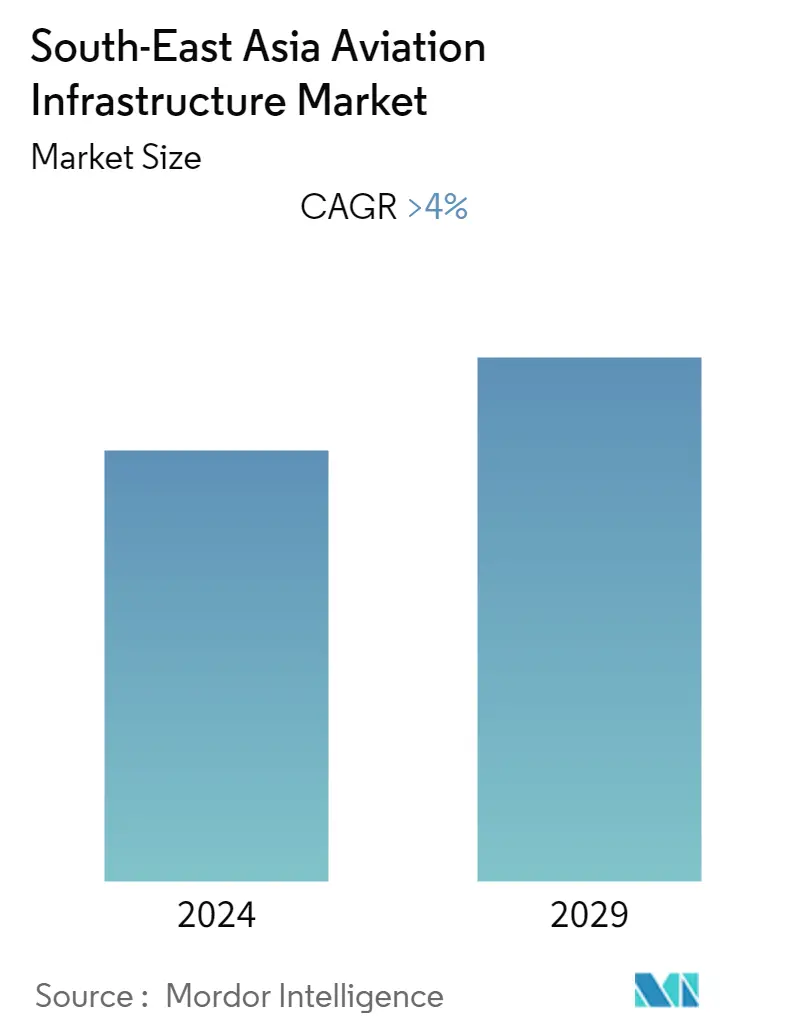Market Size of South-East Asia Aviation Infrastructure Industry

| Study Period | 2019 - 2029 |
| Base Year For Estimation | 2023 |
| Forecast Data Period | 2024 - 2029 |
| Historical Data Period | 2019 - 2022 |
| CAGR | 4.00 % |
Major Players
*Disclaimer: Major Players sorted in no particular order |
South East Asia Aviation Infrastructure Market Analysis
The South-East Asian aviation infrastructure market is anticipated to register a CAGR of over 4% during the forecast period.
- The South-East Asian aviation industry is poised for rapid expansion with estimated delivery of around 3,000 new commercial aircraft by 2032. The impetus undertaken by the regional governments in the form of the ASEAN Single Aviation Market (ASAM) depicts the role of aviation in the economic development of the ASEAN Economic Community. Thus, a significant allocation of financial resources toward the development of critical aviation infrastructure is anticipated during the forecast period.
- However, currently, the investments in aviation infrastructure development are not at par with the required rate in most South-East Asian countries due to cost escalations and other development complexities that limit the growth of the market.
South East Asia Aviation Infrastructure Industry Segmentation
The South-East Asia aviation infrastructure market covers the latest trends and technological developments in the region, and the demand by the airport type, infrastructure type, and geography. The study considers the planned investments for new airport construction, as well as the modernization plans of existing airports in the region.
| Airport Type | |
| Commercial Airport | |
| Military Airport |
| Infrastructure Type | |
| Terminal | |
| Control Tower | |
| Other Infrastructure Types |
| Country | |
| Malaysia | |
| Philippines | |
| Singapore | |
| Vietnam | |
| Indonesia | |
| Rest of South-East Asia |
South-East Asia Aviation Infrastructure Market Size Summary
The South-East Asian aviation infrastructure market is set for significant growth, driven by the region's expanding aviation industry and strategic initiatives like the ASEAN Single Aviation Market (ASAM). This growth is supported by substantial government investments aimed at enhancing critical aviation infrastructure to meet the increasing demand for air travel. Despite these efforts, challenges such as cost escalations and developmental complexities have hindered the pace of investment in some countries. The region's airports are experiencing rapid passenger growth, often operating at full capacity, which necessitates the development of larger airport facilities, including new runways and passenger terminals. Major projects, such as Indonesia's greenfield airport in Jakarta and Malaysia's Penang International Airport expansion, exemplify the ongoing efforts to bolster capacity and support the booming tourism sector.
The market's expansion is further underscored by the anticipated growth in the commercial airline fleet size, which is expected to triple by 2039. Key infrastructure projects, such as the Changi Airport Terminal 5 development in Singapore, are poised to significantly enhance passenger and cargo capacity, aligning with the region's burgeoning air travel demand. Prominent industry players, including GMR Group and AECOM Limited, are actively involved in these developments, focusing on workforce development and collaboration with airport authorities to ensure timely project completion. However, the market's growth is sensitive to economic conditions, with potential downturns posing risks of contract deferrals or cancellations, which could impact market dynamics and financial stability for key players.
South-East Asia Aviation Infrastructure Market Size - Table of Contents
-
1. MARKET DYNAMICS
-
1.1 Market Overview
-
1.2 Market Drivers
-
1.3 Market Restraints
-
1.4 Porter's Five Forces Analysis
-
1.4.1 Threat of New Entrants
-
1.4.2 Bargaining Power of Buyers/Consumers
-
1.4.3 Bargaining Power of Suppliers
-
1.4.4 Threat of Substitute Products
-
1.4.5 Intensity of Competitive Rivalry
-
-
-
2. MARKET SEGMENTATION
-
2.1 Airport Type
-
2.1.1 Commercial Airport
-
2.1.2 Military Airport
-
-
2.2 Infrastructure Type
-
2.2.1 Terminal
-
2.2.2 Control Tower
-
2.2.3 Other Infrastructure Types
-
-
2.3 Country
-
2.3.1 Malaysia
-
2.3.2 Philippines
-
2.3.3 Singapore
-
2.3.4 Vietnam
-
2.3.5 Indonesia
-
2.3.6 Rest of South-East Asia
-
-
South-East Asia Aviation Infrastructure Market Size FAQs
What is the current South-East Asia Aviation Infrastructure Market size?
The South-East Asia Aviation Infrastructure Market is projected to register a CAGR of greater than 4% during the forecast period (2025-2030)
Who are the key players in South-East Asia Aviation Infrastructure Market?
AECOM Limited, GMR Group, Mott MacDonald Group Limited, JGC Holdings Corporation and NEAPOLI Sdn Bhd are the major companies operating in the South-East Asia Aviation Infrastructure Market.

